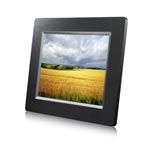Getting the picture: digital photo frames gaining in popularity
 Frankfurt, Germany - A few years ago, customers shied away from digital photo frames. Nowadays, they are the centre pieces of slide shows often with accompanying, background music.
Frankfurt, Germany - A few years ago, customers shied away from digital photo frames. Nowadays, they are the centre pieces of slide shows often with accompanying, background music.
But then, some people are already using the frame as an alarm clock or a digital photo album.
Digital photo frames first hit the market in 2007. It took them a few years to achieve widespread popularity, but now the digital multi-taskers are flying off shelves, said Constanze Clauss, a spokeswoman for the German Photo Industry Association in Frankfurt.
But how can a consumer tell the different models apart? "They're pretty much all the same in terms of quality," says Clauss, adding, "The more expensive ones have more features."
Such features can include anything from an integrated radio, calendar, clock, alarm clock to remote control. Most come with a slot for a camera's memory card, plus an interface for a USB stick. Some even come with an internal hard drive.
"Then you can just transfer the pictures and not leave the memory card stuck in the frame." Most models can hold about 4,000 pictures.
But Joachim Sauer of the magazine Colorfoto says most of these functions are just for playing around. "It's much more important that the menu is arranged in a sensible way."
Zoom, automatic rotation, cross fading and programmable time intervals are standard in most frames. Some also have photo finishing tools, so users can adjust contrast and brightness, or even remove red eye effects.
"In general, these services are only rudimentary. The pictures look better if they're finished on the computer first," advises Sauer. That also limits a loss of image quality in case the frame automatically scales down the size of the picture.
Trends are moving away from classic 7 or 8-inch frames, which can generally show pictures in a 10x15-centimetre format. Customers now favour either larger or smaller models, says Annika Hummerich, a spokeswoman for Jobo AG, one of the largest producers of digital frames for the German market.
Frames with 15-inch displays, rivalling that of a laptop, are moving out of convention halls and into living rooms. Models with mirrored surfaces are also gaining in popularity because, "When the frame is off, you have a mirror instead of a dead frame."
The 15-inch versions have one disadvantage when compared to smaller frames - they cannot be battery operated. Hummerich said the large frames used so much power that batteries were depleted too quickly.
Smaller frames, however, almost always run on battery power, meaning they can always be taken off a wall or shelf and over to the table, if you want to zoom in on a particular picture. But the small frames also use between 30 to 80 watts of energy, said Sauer.
"That's noticeable, if they run for a whole day," he said.
When picking a display, customers need to look past the plexiglas, mahogany, cool silver, neutral black or white frame, says Clauss. Apart from picture quality, it's important to check viewing angles and whether the frame can support 9x13 and 13x18 formats as well as the classic 10x15.
Claus recommends going to the store armed with a fully loaded USB stick or memory card so you can try out frame with your own pictures.
"Just like with a television, a lot depends on your personal preferences. Some people like more red in their picture. Some like more yellow."
Sauer recommends looking at the frame from both the front and side view, since it's hard to see some displays from that angle.
INFO-BOX: Resolution and contrast
To make sure your pictures look sharp, the German Photo Industry Association recommends a resolution of at least 1080x760 or 1024x768 pixels. Experts recommend a contrast setting of 400:1. (dpa)